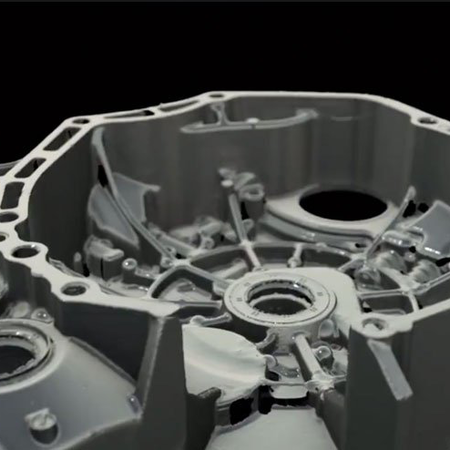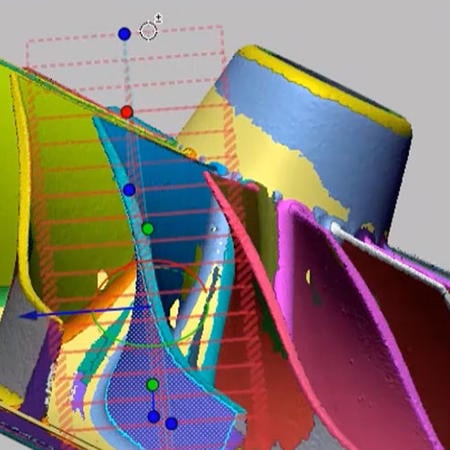July 2006
Space travel will always be a gamble, but new approaches to safety such as 3D reverse engineering and inspection are tilting the odds overwhelmingly in NASA’s favor.
"As taxpayers, you pay us to play the odds," said NASA Chief Michael Griffin before the July launch of Discovery mission STS-121. "It's called risk management."
While acknowledging risk, NASA has made major leaps since the Columbia disaster in 2003 to make space travel a safer bet. One of the biggest areas of improvement is using Geomagic reverse engineering and inspection software to detect, assess and repair, if necessary, tile damage caused by foam particles dislodged from the shuttle and other flying debris.
Heat-resistant ceramic tiles that cover the underside of Discovery are part of the thermal protection system that shields the orbiter and its astronauts from the 2,300-degree heat faced during re-entry into the Earth's atmosphere.
3D scanning for reverse engineering and inspection is the process of automatically transforming physical objects into accurate, digital 3D models, and was implemented for the first time in August 2005 for the initial Discovery mission. After proving its value in that mission, it has become an integral part of NASA's safety strategy.
3D Systems' Geomagic software provides the central technologies for NASA's implementation of this methodology. The software is used by major automotive, aerospace and consumer product manufacturers worldwide to digitally recreate complex physical objects for mass customization, more accurate analysis and simulation, and digital inventory. NASA uses Geomagic to automatically process 3D data collected from a scanner while the shuttle is in flight.
Scanning in Space
The process of capturing and digitally recreating tiles for the shuttle starts with a Neptec scanner mounted on a 50-foot-long extension of Discovery's robot arm. Neptec's Laser Camera System (LCS) uses a synchronized scanning technique patented by the National Research Council of Canada. According to Neptec, it can detect a crack as small as half a millimeter, or twice the width of a standard business card, from as far away as four meters. Unlike traditional cameras, it can operate without available light, a major consideration in space orbit, where the sun rises and sets 16 times per day.
As the shuttle nears the space station for rendezvous, it rolls over to expose its underside. Video surveys and detailed 3D scanning inspections are conducted during the approach and docking to determine damage to the tiles underneath the wings.
"Tile damage is part of space travel," says Rob Black, Geomagic account manager for the NASA Discovery project. "2D video can pick up some of it, but the details are only discernable through 3D analysis."
Digitally Replicating the Damage
Scan data from the Neptec system is transmitted to NASA's Johnson Space Center in Houston, where Geomagic is used to process the data and create a 3D model of the damaged tiles. Geomagic provides patented algorithms that speed surface generation and ensure quality for highly detailed models. Because of its high level of automation, Geomagic requires very little training; a logical workflow enables users to maintain proficiency even if they don't work with the software on a daily basis.
The 3D surface model created in Geomagic is used by NASA engineers to assess the level of damage to the tiles. If the digital model indicates a safety threat, engineers create a toolpath to replicate the damage on an array of test tiles. The reproductions of the damaged tiles are tested in NASA's ArcJet facility to see if they can withstand the heat and stress of reentry.
If damage is considered too extensive for safe reentry, the situation could call for a spacewalk by astronauts to make the repair. In this case, the test tiles would be used to develop the step-by-step repair process. Fortunately, in-flight repair has not been necessary in the two previous Discovery flights, as analysis of scan data showed that damage was not severe enough to put the orbiter at risk during reentry.
A Natural Choice
Geomagic was a natural choice to fill this key role with NASA, based on the company's long-standing relationship with the agency and its leadership in helping organizations use reverse engineering and inspection to accelerate their design-build cycles and ensure quality.
"NASA's selection of Geomagic for the Return-to-Flight initiative is a major validation of our software’s high level of automation, speed, reliability and accuracy,” says Black. "It is a privilege to provide software and support for a project with such national significance."
While Geomagic is proud that its software is helping to ensure safety on shuttle missions, this is the rare case where the company doesn't want a product to be used to its full capability in a real-life situation.
"We're keeping our fingers crossed that Geomagic is never used to manufacture test tiles for a spacewalk repair during an actual mission," says Black.

